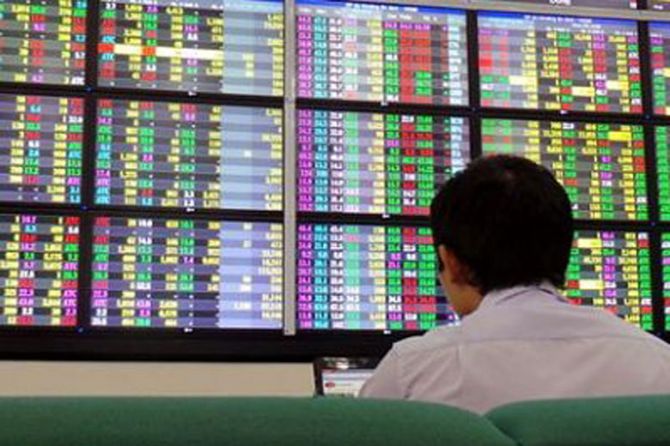 | « Back to article | Print this article |
 The forecasts of the projected path of interest rates by the US Federal Reserve seem to indicate a full percentage increase over the next year; and that is quite hefty, note Abheek Barua and Bidisha Ganguly
The forecasts of the projected path of interest rates by the US Federal Reserve seem to indicate a full percentage increase over the next year; and that is quite hefty, note Abheek Barua and Bidisha Ganguly
Well you can’t blame the US Federal Reserve for either disappointing the markets or taking them by surprise.
On December 16, it raised the policy rate, the Fed Funds rate, by a quarter of a percentage point in line with the majority expectation and the communication that it was perhaps as gentle as it gets.
“The stance of monetary policy remains accommodative after this increase,” the policy statement said, “thereby supporting further improvement in labour market conditions and a return to two per cent inflation.”
It also made it amply clear that its pace of hiking rates would be more gradual than over past hiking cycles.
Here’s some more of the soothing Fed-speak: “The committee (referring to its all-powerful open market committee) expects that economic conditions will evolve in a manner that will warrant only gradual increases in the Federal Funds rate; the funds rate is likely to remain, for some time, below levels that are expected to prevail in the longer run.”
Thus, it is not surprising that familiar financial benchmarks like the Nifty went up by 1.2 per cent and the rupee gained.
This was true for most Asian markets and some emerging market currencies.
But, for those of us who make a living from parsing every sentence in policy statements and nitpicking over apparently minor detail, a couple of things rankle.
First, the forecasts of the projected path of interest rates by Fed members seem to indicate a full percentage increase over the next year and that, in our opinion, is quite hefty.
The market seemed to be pooh-poohing this and the Fed Funds Futures market shows that the market expects just two hikes over 2016, while other surveys show three hikes expected at best.
Second, there was unanimity among the voting members of the open market committee that rates should be increased.
For old Fed hands who find hidden messages in these things, this unanimity is uncommon and all members stepping on the same side means a certain degree of hawkishness.
Are we reading too much into these innocuous things?
Well, going by the way markets have behaved, we might not quite be imagining problems when none exist.
The US’ principal stock-market index, the Dow, sold off by as much as 1.4 per cent after the announcement, as did a number of other developed stock markets.
Asian emerging market stock prices did see a bounce post Fed-talk, but as we write this on Friday morning, there appears to be a reversal in these markets.
Currencies that had appreciated in the wake of the Fed hike also appear to be shedding their gains.
While we concede that a major reversal in interest rates is likely to be followed by fairly volatile reactions from markets, one interpretation is that the 'dovish hike', the delightful oxymoron that the markets are using to describe the Fed’s move, was not so dovish after all.
For the Indian currency and financial markets, there is another looming risk that might compound the troubles that a more-than-expected aggression from the Fed can bring.
That stems from China allowing its currency to depreciate further.
Much as it is trying to boost domestic consumption, the Asian giant is still reliant on exports to pull growth up and, thus, more depreciation clearly suits its case.
There is, of course, the fear that China is sitting on piles of dollar debt and a falling yuan could make servicing this debt difficult.
This is certainly true, but there is some anecdotal evidence that China is trying to lighten its load of dollar debt and encouraging refinancing in local currency.
Having attained Special Drawing Rights status, it has an additional incentive to depreciate in order to bolster the yuan bond market, particularly the Panda market that helps investors dip into China’s massive household savings pool.
Depreciation in the Chinese currency is likely to have a knock-on effect on all Asian emerging market currencies, including the rupee.
And this time around, China will not have to 'manipulate' its currency.
All it needs to do is to allow the markets to guide its currency’s path, something Western institutions have always insisted on. All above-board, all kosher.
Abheek Barua is chief economist, HDFC Bank. Bidisha Ganguly is principal economist, CII
The image is used for representational purpose only. Photograph: Reuters